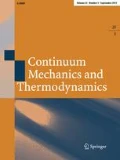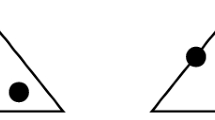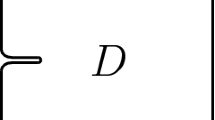Abstract
Transport equations in integral form are well established for analysis in continuum fluid dynamics but less so for solid mechanics. Four classical continuum mechanics transport equations exist, which describe the transport of mass, momentum, energy and entropy and thus describe the behaviour of density, velocity, temperature and disorder, respectively. However, one transport equation absent from the list is particularly pertinent to solid mechanics and that is a transport equation for movement, from which displacement is described. This paper introduces the fifth transport equation along with a transport equation for mechanical energy and explores some of the corollaries resulting from the existence of these equations. The general applicability of transport equations to discontinuous physics is discussed with particular focus on fracture mechanics. It is well established that bulk properties can be determined from transport equations by application of a control volume methodology. A control volume can be selected to be moving, stationary, mass tracking, part of, or enclosing the whole system domain. The flexibility of transport equations arises from their ability to tolerate discontinuities. It is insightful thus to explore the benefits derived from the displacement and mechanical energy transport equations, which are shown to be beneficial for capturing the physics of fracture arising from a displacement discontinuity. Extended forms of the Rankine–Hugoniot conditions for fracture are established along with extended forms of J -integrals.
Similar content being viewed by others
References
Chorin, A., Marsden, J.E.: A Mathematical Introduction to Fluid Mechanics, 3rd edn, pp. 1–11. Springer, London. ISBN: 3540979182 (1993)
Salencon, J.: Handbook of Continuum Mechanics: General Concepts Thermoelasticity (translated by Lyle S.), pp. 31–101. Springer, Berlin. ISBN: 3540414436 (2001)
Griffith A.A.: The phenomena of rupture and flow in solids. Phil. Trans. R. Soc. A 221, 163–198 (1921) doi:10.1098/rsta.1921.0006
Griffith, A.A.: The theory of rupture. In: Proceedings of the 1st International Congress of Applied Mechanics. pp. 55–63. Delft (1924)
Eftis J., Liebowitz H.: On surface energy and the continuum thermodynamics of brittle fracture. Eng. Fract. Mech. 8, 459–485 (1976) doi:10.1016/0013-7944(76)90002-3
Gurtin M.E.: Thermodynamics and the Griffith criterion for brittle fracture. Int. J. Solids Struct. 15, 553–560 (1979) doi:10.1016/0020-7683(79)90082-9.
Seliger R.L., Whitham G.B.: Variational principles in continuum mechanics. Proc. R. Soc. Lond. A 305(1480), 1–25 (1968) doi:10.1098/rspa.1968.0103
Gurtin M.E., Voorhees P.W.: The continuum mechanics of coherent two-phase elastic solids with mass transport. Proc. R. Soc. Lond. A 440(1909), 323–343 (1993) doi:10.1098/rspa.1993.0019
Smyshlyaev V.P., Willis J.R.: On the relation of a three-well energy. Proc. R. Soc. Lond. A 445(1983), 779–814 (1999) doi:10.1098/rspa.1999.0335
Scholle M.: Construction of Lagrangians in continuum theories. Proc. R. Soc. Lond. A 460(2051), 3241–3260 (2004) doi:10.1098/rspa.2004.1354
Sandhu R.S., Pister K.S.: Variational principles for boundary value and initial boundary value problems in continuum mechanics. Int. J. Solids Struct. 7(7), 639–654 (1971) doi:10.1016/0020-7683(71)90085-0
Santaoja K.: Basics of Griffith’s fracture mechanics. Rakenteiden Mekaniikka 25(3), 3–23 (1992)
Guź A.N.: Identification of Lagrangian and Eulerian coordinates in continuum mechanics. Int. Appl. Mech. 34(10), 965–968 (1998) doi:10.1007/BF02701051
Tan C.L., Fenner R.T.: Elastic fracture mechanics analysis by the boundary integral equation method. Proc. R. Soc. Lond. A 369(1737), 243–260 (1979) doi:10.1098/rspa.1979.0162
Vitali E., Benson D.J.: Modeling localized failure with arbitrary Lagrangian Eulerian methods. Comput. Mech. 49(2), 197–212 (2012) doi:10.1007/s00466-011-0632-3
Mariano P.M.: Influence of the material substructure on crack propogation: a unified treatment. Proc. R. Soc. Lond. A 461(2054), 371–395 (2005) doi:10.1098/rspa.2004.1392
Ma L., Korusunsky A.M.: Vector J-integral analysis of crack initiation at the edge of complete sliding contact. Proc. R. Soc. Lond. A 462(2070), 1805–1820 (2006) doi:10.1098/rspa.2005.1650
Salas M.D.: The curious events leading to the theory of shock waves. Shock Waves 16(6), 477–487 (2007) doi:10.1007/s00193-007-0084-z
Truesdell C., Noll W.: The Non-linear Field Theories of Mechanics, pp. 66–77. Springer, Berlin (2013)
Von Westenholz, C.: Differential Forms in Mathematical Physics, pp. 208–223. Elsevier, Amsterdam. ISBN: 0720405378 (1978)
Kondepudi, D., Prigogine, I.: Modern Thermodynamics: From Heat Engines to Dissipative Structures, pp. 1–479. Wiley, Hoboken. ISBN: 0471973939 (1998)
Davey K., Mondragon R.: A non-physical enthalpy method for the numerical solution of isothermal solidification. Int. J. Numer. Methods Eng. 84(2), 214–252 (2010) doi:10.1002/nme.2896
Needleman A.: A continuum model for void nucleation by inclusion debonding. J. Appl. Mech 54, 525–531 (1987) doi:10.1115/1.3173064
Needleman A.: An analysis of tensile decohesion along an interface. J. Mech. Phys. Solids 38(3), 289–324 (1990) doi:10.1016/0022-5096(90)90001-K
Chaboche J., Girard R., Levasseaur P.: On the interface debonding models. Int. J. Damage Mech. 6(3), 220–257 (1997) doi:10.1177/105678959700600302
Ortiz M., Pandolfi A.: Finite-deformation irreversible cohesive elements for three-dimensional crack-propagation analysis. Int. J. Numer. Methods Eng 44(9), 1267–1282 (1999) doi:10.1002/(SICI)1097-0207(19990330)44:9<1267::AID-NME486>3.0.CO;2-7
Pandolfi A., Guduru P.R., Oritz M., Rosakis A.J.: Three dimensional cohesive element analysis and experiments of dynamic fracture in C300 steel. Int. J. Solids Struct 37(27), 3733–3760 (2000) doi:10.1016/S0020-7683(99)00155-9
Tvergaard V.: Crack growth predictions by cohesive zone model for ductile fracture. J. Mech. Phys. Solids 49(9), 2191–2207 (2001) doi:10.1016/S0022-5096(01)00030-8
Nguyen O., Repetto E.A., Ortiz M., Radovitzky R.A.: A cohesive model of fatigue crack growth. Int. J. Fract 110(4), 351–369 (2001) doi:10.1023/A:1010839522926
Roe K.L., Siegmund T.: An irreversible cohesive zone model for interface fatigue crack growth simulation. Eng. Fract. Mech. 70(2), 209–232 (2003) doi:10.1016/S0013-7944(02)00034-6
Rice J.R.: A path independent integral and the approximate analysis of strain concentration by notches and cracks. J. Appl. Mech 35, 379–386 (1968) doi:10.1115/1.3601206
Rice J.R., Drucker D.C.: Energy changes in stressed bodies due to void and crack growth. Int. J. Fract. Mech. 3, 19–27 (1967)
Truesdell C.: The Elements of Continuum Mechanics, pp. 9–17. Springer, Berlin (2012)
ANSYS@Academic Research, Release 16.1, Help System, Mechanical Applications/APDL, Ansys, Inc
Shen L.-J.: On the decomposition of deformation into elastic–plastic parts. J. Appl. Mech. 65, 1059–1061 (1998) doi:10.1115/1.2791901
Author information
Authors and Affiliations
Corresponding author
Additional information
Communicated by Andreas Öchsner.
Rights and permissions
About this article
Cite this article
Davey, K., Darvizeh, R. Neglected transport equations: extended Rankine–Hugoniot conditions and J -integrals for fracture. Continuum Mech. Thermodyn. 28, 1525–1552 (2016). https://doi.org/10.1007/s00161-016-0493-2
Received:
Accepted:
Published:
Issue Date:
DOI: https://doi.org/10.1007/s00161-016-0493-2




